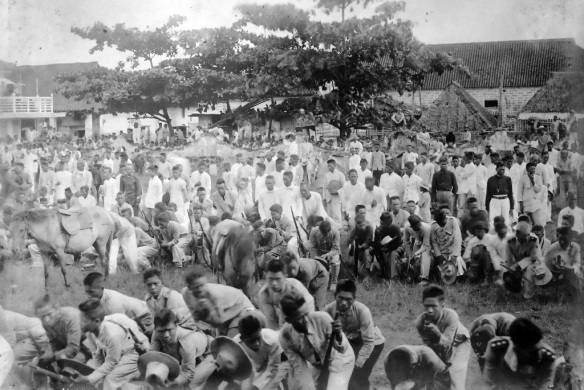Surrender of Filipino insurgents.
Philippine Constabulary.
In economic terms, American colonial rule in the Philippines promoted an intensely dependent, export economy based on cash-crop agriculture and extractive industries like mining. American capital had initially regarded the Philippines as merely a ‘‘stepping stone’’ to the fabled China market, and American trade with the Philippine Islands was initially inhibited by reciprocity treaties that preserved Spanish trade rights. When these rights ended, U.S. capital divided politically over the question of free trade. American manufacturers supported free trade, hoping to secure in the Philippines both inexpensive raw materials and markets for finished goods, whereas sugar and tobacco producers opposed free trade because they feared Philippine competition. The Payne-Aldrich Tariff of 1909 established ‘‘free trade,’’ with the exception of rice, and set yearly quota limits for Philippine exports to the United States.
American trade with the Philippine Islands, which had grown since the war, boomed after 1909, and during the decades that followed, the United States became by far the Philippines’ dominant trading partner. American goods comprised only 7 percent of Philippine imports in 1899, but had grown to 66 percent by 1934. These goods included farm machinery, cigarettes, meat and dairy products, and cotton cloth. The Philippines sold 26 percent of its total exports to the United States in 1899, and 84 percent in 1934. Most of these exports were hemp, sugar, tobacco, and coconut products.
Free trade promoted U.S. investment, and American companies came to dominate Philippine factories, mills, and refineries. When a post–World War I economic boom brought increased production and exports, Filipino nationalists feared economic and political dependence on the United States, as well as the overspecialization of the Philippine economy around primary products, overreliance on U.S. markets, and the political enlistment of American businesses in the indefinite colonial retention of the Philippine Islands.
Meanwhile, rural workers subject to the harsh terms of export-oriented development challenged the power of hacienda owners in popular mass movements. While some interested American companies did lobby against Philippine independence, during the Great Depression powerful U.S. agricultural producers—especially of sugar and oils—supported U.S. separation from the Philippines as a protectionist measure to exclude competing Philippine goods. The commonwealth period and formal Philippine independence would be characterized by rising tariffs and the exclusion of Philippine goods from the U.S. markets upon which Philippine producers had come to depend.
Philippine-American colonialism also transformed both the Philippines and the United States in cultural terms. In the Philippines, the colonial state introduced a secular, free public school system that emphasized the English language (believed by U. S. officials to be the inherent medium of ‘‘free’’ institutions), along with industrial and manual training to facilitate capitalist economic development. While the Filipino elite retained and developed Spanish as a language of literature, politics, and prestige into the 1920s—often contrasted with ‘‘vulgar’’ Americanism—Filipinos increasingly learned and transformed English and used it to their own purposes. Filipinos also reworked forms and elements from American popular culture, especially in film, fashion, and literature. In addition, this period saw the development of popular and literary culture in other Philippine languages. With the advent of the commonwealth, Tagalog was declared the unifying ‘‘national’’ language.
The struggle for Philippine independence fundamentally shaped emerging Filipino modes of self-identification, as Filipinos sought to prove their ‘‘capacity’’ for ‘‘self-government.’’ Where the U.S. colonial state administered ‘‘non-Christian’’ regions inhabited by animists and Muslims through separate, American-dominated political and military controls (insulating them from emerging ‘‘national’’ politics), Filipino nationalists sought to integrate these regions and peoples into the ‘‘nation’’ by arguing for their rights to administer them undemocratically on the basis of the ‘‘civilizational’’ superiority of Christian Filipinos.
American culture would also be transformed culturally by Philippine-American colonialism. Beginning in the 1920s, mass Filipino labor migration to Hawaii and the American West would alter both region’s culture and demography, bridging the Philippine and U.S. cultural and social worlds. At the same time, official justifications of conquest and colonial administration helped accommodate Americans more generally to the notion that overseas empire was compatible with a ‘‘republic.’’ American colonial rule in the Philippines was held up domestically and internationally as symbolic of the United States’ own exceptional democracy and foreign policy. American policy toward the Philippines following World War II— characterized by Cold War anticommunism—suggested continuities with the colonial period.
BIBLIOGRAPHY Cullinane, Michael. Ilustrado Politics: Filipino Elite Responses to American Rule. Quezon City: Ateneo de Manila University Press, 2005. Go, Julian, and Anne Foster, eds. The American Colonial State in the Philippines: Global Perspectives. Durham: Duke University Press, 2003. Guerrero, Milagros C. Under Stars and Stripes. Vol. 6, Kasaysayan: The Story of the Filipino People. Asia Publishing Co., 1998. Kramer, Paul A. The Blood of Government: Race, Empire, the United States and the Philippines. Chapel Hill: University of North Carolina Press, 2006. Miller, Stuart Creighton. ‘‘Benevolent Assimilation’’: The American Conquest of the Philippines, 1899-1903. New Haven, CT: Yale University Press, 1982. Paredes, Ruby, ed. Philippine Colonial Democracy. Quezon City: Ateneo de Manila University Press, 1989.
